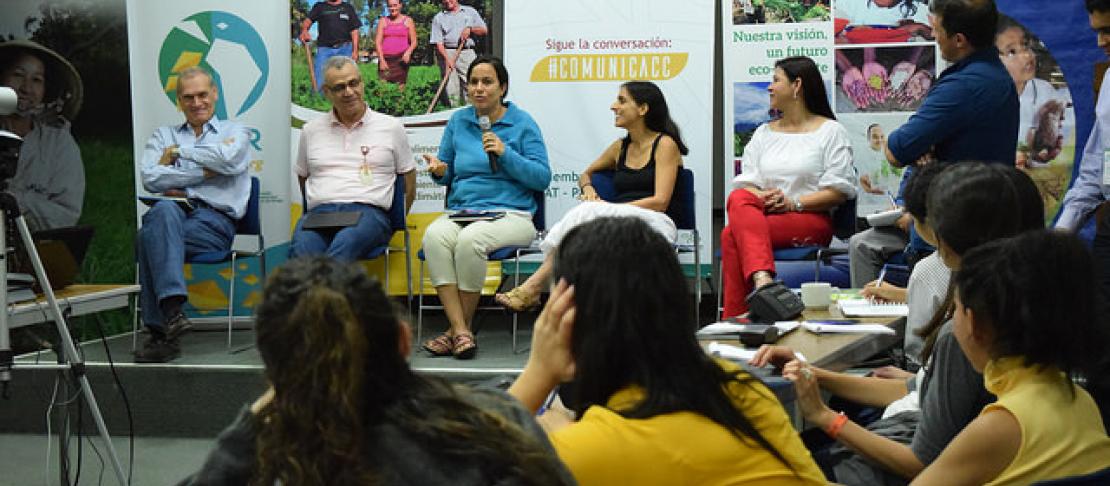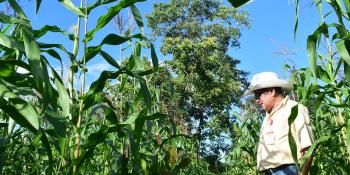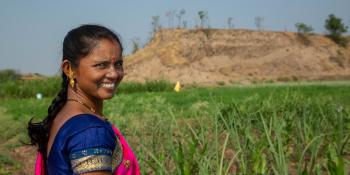Five senses to communicate science

A group of journalists from Latin American countries gathered for a second international workshop on scientific journalism.
With the slogan the challenge of communicating science, the International Center for Tropical Agriculture (CIAT), the CGIAR Research Program on Climate Change, Agriculture and Food Security (CCAFS), the Latin American Fund for Irrigated Rice (FLAR) and HarvestPlus, convened a group of 20 journalists from 10 countries in Latin America to participate in the 2nd International Workshop on Scientific Journalism, which took place on December 5 and 6, 2016 at CIAT headquarters, in Palmira, Colombia.
The workshop aimed for journalists to understand the effects of climate change, feel the intense cold of the vault where bean seeds are conserved at -18 degree Celsius, listen to scientists who work to make the staple crops more nutritious, learn about the use of drones in science, and taste rice to help determine its culinary quality. Participants were encouraged to share photos, videos and phrases with the official hashtag of the event: #ComuniCACC.
Led by Federico Kukso, Argentinian science journalist, the group went deep inside the heart of CIAT to learn with all senses. "In science communication, there is nothing better than being there: seeing, hearing, smelling, walking through the laboratories, talking to scientists face to face. The stories are much richer and complete", Kukso explained before starting the day.
The first day began with the welcome greetings of Eduardo Graterol, Executive Director of FLAR and Ana María Loboguerrero, CCAFS Latin America Regional Leader, who offered a general look at the work of the four institutions that came together to carry out the workshop.
Later, the CIAT scientist Jeimar Tapasco spoke about the adaptation and mitigation, challenges and opportunities in the face of climate change. With figures, graphs, animations and a powerful speech, Tapasco invoked journalists' curiosity, who continued the journey with a tour of CIAT, where they put their senses to test.
Walking through CIAT with all the senses
How do you keep seeds at -18 degrees Celsius? Journalists invited to the workshop are figuring it out #comuniCACC @fedkukso pic.twitter.com/Ed1p2HKG5x
— Adriana Varón (@adriana_varon) 5 de diciembre de 2016
How do you keep seeds at -18 degrees Celsius? Journalists invited to the workshop are figuring it out.
Touch: Journalists tested their cold tolerance in the vault where thousands of varieties of beans and fodder from 131 countries are stored at -18 degree Celsius. Daniel Debouck, Luis Guillermo Santos and Ericson Aranzales were the experts in genetic resources that took journalists for the journey of the seed conservation.
Panel: el reto de divulgar la ciencia con @fedkukso Científicos hablan sobre su experiencia con el periodismo. @cgiarclimate_LA #ComunicaCC pic.twitter.com/85M9DCDT6a
— Byron Sosa (@byronsosa5) 6 de diciembre de 2016
Panel discussion: the challenges of communication science with @fedkukso. Scientists talking about their experiences with journalists. @cgiarclimate_LA #ComunicaCC
Hearing: During the workshop, different Spanish accents were heard from journalists and communication officers from Argentina, Colombia, Ecuador, Guatemala, Mexico, Nicaragua, El Salvador, Peru and Uruguay. Participants also heard the different arguments of the panel formed by CIAT researchers (Daniel Debouck, Paul Chavarriaga, Carolina González and Ana María Loboguerrero) and invited journalists (Ximena Serrano and Carlos Antonio Gutiérrez) who spoke about the challenges faced when disseminating science.
"Drones al servicio de la ciencia" equipos de teledeteccion para medir estrés hídrico de los cultivos de arroz #ComuniCACC pic.twitter.com/PrX16qFc57
— CCAFS Latin America (@cgiarclimate_LA) 5 de diciembre de 2016
"Drones in the service of science" remote sensing equipment to measure water stress of rice crops #ComuniCACC
Sight: Workshop attendees had to adjust their sight to the orange lighting of the HarvestPlus Nutritional Quality Laboratory. This is where scientists extract vitamin A that they then incorporate into crops like maize, transforming them into biofortified foods with a high nutrient content.
During the visit to the field, the invited journalists could see the use of sensors and drones in agriculture, which give the possibility of validating and giving scientific power to the images. As they say, "a picture speaks a thousand words".
Conociendo sobre el cultivo del arroz en directo. #ComuniCACC pic.twitter.com/F9xsJGPdfd
— Adriana Varón (@adriana_varon) 5 de diciembre de 2016
Learning about the rice crop LIVE! #ComniCACC
Smell: Undoubtely, the noses of some of the attendees kept the memory of the smell of an experimental plot of biofortified rice. Water, mud, and sun created an unforgettable memory for those who for the first time knew how rice is cultivated, beyond a plate. The experience will be even more stuck to the Colombian journalist Laura Betancur, who encouraged herself to get into the mud and plant rice.
Los periodistas se convirtieron en panelistas durante la prueba sensorial de arroz en el laboratotio de calidad @arrozFLAR pic.twitter.com/KCEZwmIYfC
— FLAR (@arrozFLAR) 5 de diciembre de 2016
Journalists become tasters during the rice taste panel in the rice quality lab @arrozFLAR
Taste: The visit to the FLAR's Rice Quality Lab sharpened several senses: sight, taste and smell. There, journalists were part of a focus group to evaluate the stickness and gloss of three commercial Latin American rice varieties. Participants ate rice with a purpose: to find the variety with better taste.
Also, during the two days of the event, the journalists delighted their taste with typical Colombian recipes that included bean biofortified by HarvestPlus as star ingredient.
"Story Hunters" with Federico Kukso
The icing on the cake was the keynote of the scientific journalist Federico Kukso. He is a former researcher at MIT and Harvard in the United States, and an author of articles in Scientific American, El Pais (Spain), Agencia Sinc (Spain), Muy Interesante (Argentina), Le Monde Diplomatique (France), La Nación (Argentina), Tec Review (Mexico), among others.
Kukso shared his experience through the talk 'Story Hunters: Why write about science matters', catching the attention of Latin American journalists who were sharing the highlights of his conference on social media.
Through different emotions, visual resources, advices, historical and scientific facts and his own experiences, Kukso was leaving a seed in each journalist about why to write about science matters, the importance to generate participation around science, why it is journalists' job as well to disseminate science, why it is critical to creat an emotional link between a subject and the scientist, the importance of innovating in the way the stories are told and the value of initiatives such as this workshop in the setting up of a community that grows its interest in scientific issues.
Media outreach
Thanks to the II International Workshop on Scientific Journalism, Latin American journalists see the science in action from laboratories and fieldwork, allowing them to interact face to face with scientists. As a result of this, they published a number of stories:
- Cali protects our seeds for eternity Cali resguarda nuestras semillas para la posteridad - Scientific American
- VIDEO: Adaptation of cassava varieties in new climatic scenarios in Central America VIDEO: Adaptan variedades de yuca en nuevos escenarios climáticos de Centroamérica - ConexiónCOP
- Guardians of tomorrow's food Guardianes del alimento de mañana - La Prensa
- Drones are the new 'eyes' of agricultural scientists Los drones son los nuevos 'ojos' de los científicos de la agricultura - El Tiempo
- Colombians working at -18 ° C to preserve seeds Los colombianos que trabajan a -18 °C para conservar semillas - El Espectador
- Drones can improve agriculture Drones podrían mejorar el agro - La Prensa
#ComuniCACC
Thanks to the use of the #ComuniCACC hashtag, the II International Workshop on Scientific Journalism was trending topic for a few hours on Twitter:
El Segundo Taller Internacional de #PeriodismoCientífico es tendencia en #Twitter - Cali. Los invitamos a seguirlo: #ComuniCACC pic.twitter.com/d7dqqMyZzF
— CIAT (@CIAT_) 5 de diciembre de 2016
The Second International #Sciencemedia workshop is trending topic in #Twitter – Cali. We invite you to follow up: #ComuniCACC
Visit the event's photo gallery:
Adriana Varón, Ximena Escobar, Christian Zapata and José Luis Urrea are communication managers for CIAT, FLAR, HarvestPlus y CCAFS Latin America, respectively.
Translated from the FLAR Storify - Read the original


